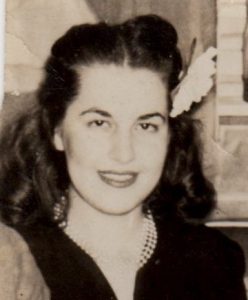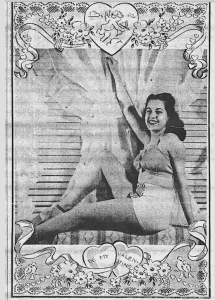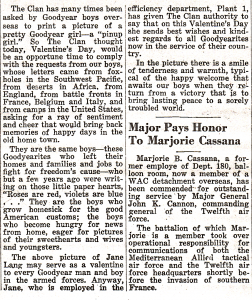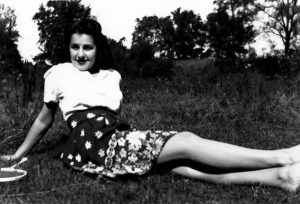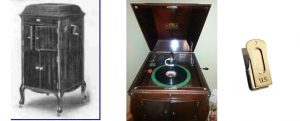When I graduated from high school in 1951 my first job was at a strip mine in Deerfield working summers and weekends while I attended Kent State University. There I drove a dump truck, ran a D7 bulldozer, welded bucket teeth for the power shovels and dragline, repaired tires, set dynamite, and other odd jobs. At times the company would buy surplus equipment from ordinance depots in various parts of the country and I would ferry these back to the mine.
The first summer I was put on a dragline as an oiler. A dragline is a large machine with a 120 foot boom that sits on top of the mine pit and uncovers the seam of coal. This one was run by a 2 man crew – an operator and an oiler. The oiler keeps the dragline fueled and lubricated, runs the bulldozer to build the ramp on top of the high wall where the machine sits, keeps the light plant running at night, and does various other jobs. Since the dragline ran 24 hours per day each crew worked a “swing shift” – one week 7AM to 3PM, next week 3 to 11, and the 3rd week 11 to 7, etc. This was exciting work for me but difficult physically because my body never got used to the change in hours, and I always felt fatigued.

The dragline operators were very skilled at their job but were a wild bunch of individuals. For them sex was not a spectator sport. They did not greet you with “Good Morning” or “Good afternoon”, but with “Are ya gettin’ any? ”. After their night shift they would often visit the “Homeworth Laundry” and come back with wild tales about Peaches LaFluf, Lena the Hyena, or Linda – the girl with the magnetic tongue. This was quite a bit to handle for a naive 17 year old kid with a strict Catholic background.
One night my operator ran out of matches and could not light his cigarette. He asked me for a match but I didn’t carry them, so he poured some gasoline on the catwalk, lit it with a torch lighter, and dipped his gloved hand into the flaming gasoline. Now he had 5 flaming fingers which he held up to his grinning face and lit the cigarette. In the dark he looked like the devil himself when those flaming fingers lit up his evil-looking face.
Sometimes when I was working the night shift one of my buddies would visit me. My favorite thing was to have them ride with me on the D7. Riding on a dozer at night in a strip mine is quite a scary experience to someone who has never done it. I would push a load of dirt over the high wall, dropping the blade over the edge. The heavy blade would cause the dozer to pitch forward giving the sensation that you were about to take a 70 foot plunge into the dark abyss riding a 26 ton machine. More than once my rider would abandon ship and “jump for his life”.

Now for the dynamite. The dynamite was used to break up the rock so the dragline could uncover the seam of coal. Each stick was 6 inches in diameter by 2 feet long and weighed 12.5 pounds. They were packed 4 to a 50 pound box. A driller would drill a series of 9 inch diameter holes each 60 feet deep into the high wall. He would drill maybe 12 of these holes 20 feet apart. Then we poked 15 to 20 sticks of dynamite into each hole with a long pole. We plugged the hole with dirt and connected the whole works together with an explosive rope called primacord, attached an electric cap with a long wire to a generator-plunger, and took cover. When the explosion occurred, the earth shuddered with a tremendous jolt and the sky blackened for several minutes with flying dirt and large rocks.

On inspecting the spoil banks during one of my night shifts I noticed that not all of these dynamite sticks had exploded. Some had been dug out by the dragline undamaged, and since they were never going to be used again, I could pick them up and take them home.
This opened up a whole new set of interesting possibilities!
After consulting with Kenny, my idea man and partner in crime, we decided that these large sticks would be ideal for celebrating New Year’s Eve. We set up two sticks in the woods on top of Sand Hill. I put in a cap and fuse and lit it at 12 midnight, making sure nobody was too close.
Sand Hill is about one and one half miles from Randolph Center. The explosion reportedly knocked dishes off of shelves there.
That night my friend Tom Hogan was working at the Sohio station across the road from my home. We stopped there later and Tom told me that my dad had been in and asked if he knew where Gene was. Tom told him that he hadn’t seen me. “Did you just hear a loud noise?”, Dad asked Tom.
You can fool most people most of the time but you can’t fool Dad! I will say that Dad never brought it up, but this is how he let me know that he knew.
Not all of the sticks I found were as large as the high wall blasters. Some were only a foot long and one inch in diameter. These were good for smaller jobs – like fishing. We could throw one into a pond and the concussion would cause fish to come to the surface. We then paddled around the pond and gathered them up. It sure beat putting a dirty old worm on a hook!
Then there was the well on Kenny’s parents property that had gone partially dry. Kenny’s mom complained about this so we decided to do her a favor and loosen it up a bit. This well had a piece of pipe sticking out of the ground about 2 feet and was open at the top. We dropped in a stick of dynamite and fired er’up.
That thing went off like a cannon, shooting rocks bigger than baseballs high into the air. I have no idea how they all got out of that small pipe. Neighbor Frank Lang was sitting in his yard across the road and big rocks were falling all around him. Fortunately God was with him that day and he didn’t get hit.
Our theory on well-restoration was not very good because not one drop of water was ever obtained from that well again.
